Exploring Themes and Characters in Powwow Highway (1989) - Review
VerifiedAdded on 2023/01/19
|6
|1420
|75
Essay
AI Summary
This essay provides a comprehensive review of Jonathan Wacks' 1989 film, Powwow Highway, a road movie that delves into the experiences of Native Americans. The review explores the film's plot, characters, and themes, focusing on the friendship between Philbert and Buddy as they embark on a journey to rescue Buddy's sister. It analyzes the contrasting personalities of the protagonists, Philbert's search for cultural identity and Buddy's more pragmatic approach. The essay highlights the film's depiction of Native American culture, the challenges faced by Native Americans, and the stereotypes they encounter. It also discusses the film's critical reception and its significance in portraying Native American perspectives, including the themes of prejudice, the struggle for cultural preservation, and the importance of community. The review references the movie's awards and its exploration of identity, resilience, and the complexities of Native American life in the United States.
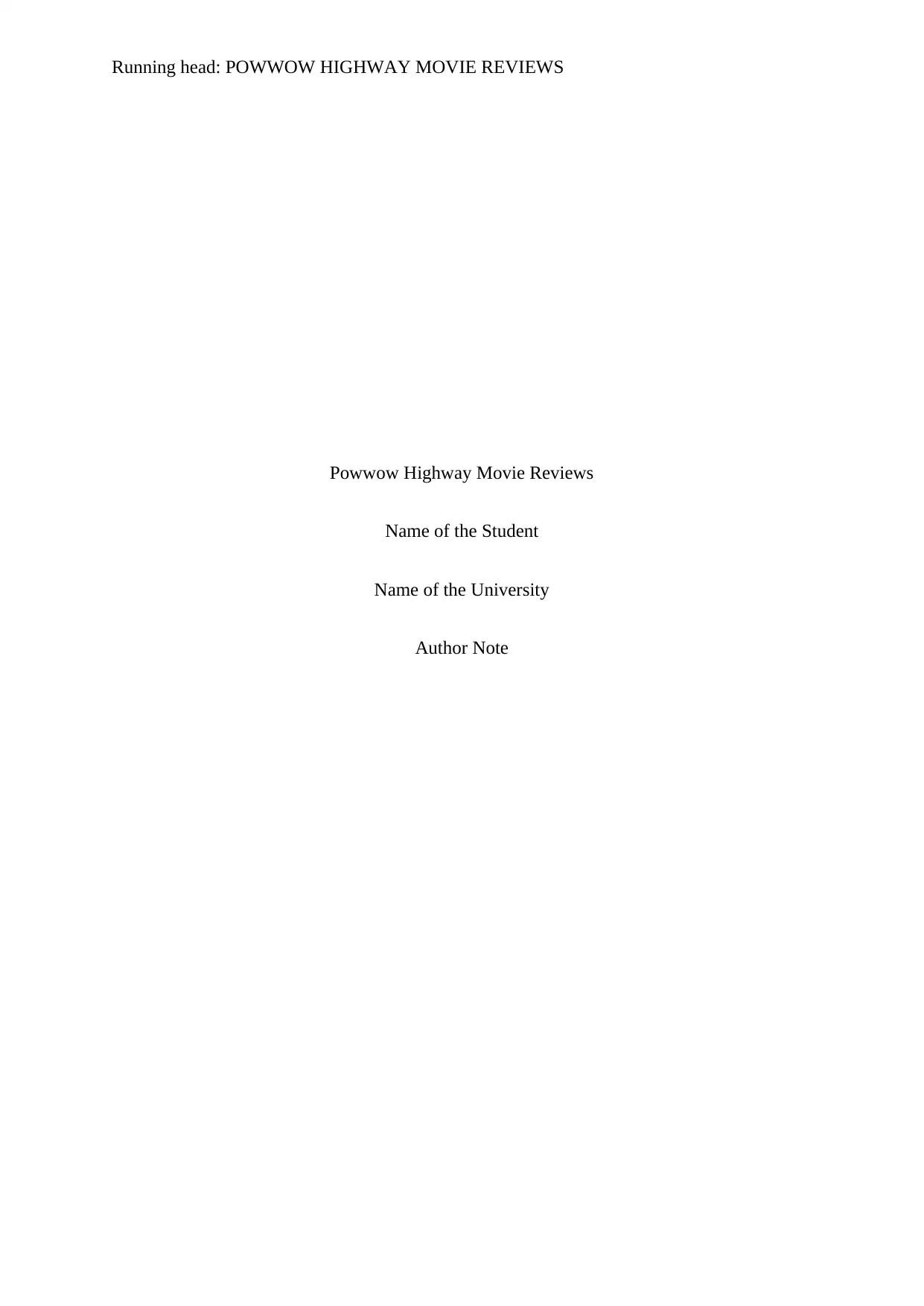
Running head: POWWOW HIGHWAY MOVIE REVIEWS
Powwow Highway Movie Reviews
Name of the Student
Name of the University
Author Note
Powwow Highway Movie Reviews
Name of the Student
Name of the University
Author Note
Paraphrase This Document
Need a fresh take? Get an instant paraphrase of this document with our AI Paraphraser
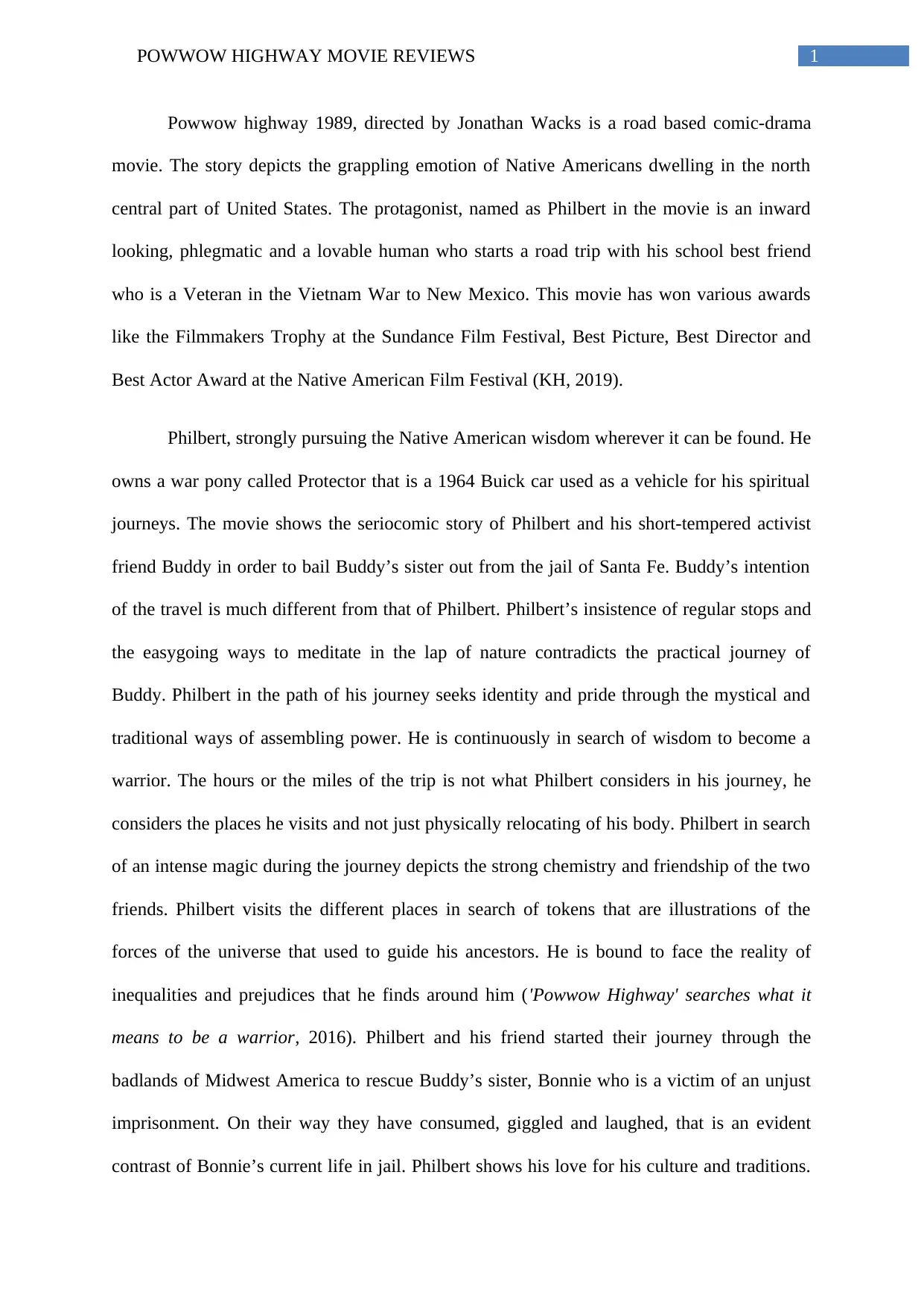
1POWWOW HIGHWAY MOVIE REVIEWS
Powwow highway 1989, directed by Jonathan Wacks is a road based comic-drama
movie. The story depicts the grappling emotion of Native Americans dwelling in the north
central part of United States. The protagonist, named as Philbert in the movie is an inward
looking, phlegmatic and a lovable human who starts a road trip with his school best friend
who is a Veteran in the Vietnam War to New Mexico. This movie has won various awards
like the Filmmakers Trophy at the Sundance Film Festival, Best Picture, Best Director and
Best Actor Award at the Native American Film Festival (KH, 2019).
Philbert, strongly pursuing the Native American wisdom wherever it can be found. He
owns a war pony called Protector that is a 1964 Buick car used as a vehicle for his spiritual
journeys. The movie shows the seriocomic story of Philbert and his short-tempered activist
friend Buddy in order to bail Buddy’s sister out from the jail of Santa Fe. Buddy’s intention
of the travel is much different from that of Philbert. Philbert’s insistence of regular stops and
the easygoing ways to meditate in the lap of nature contradicts the practical journey of
Buddy. Philbert in the path of his journey seeks identity and pride through the mystical and
traditional ways of assembling power. He is continuously in search of wisdom to become a
warrior. The hours or the miles of the trip is not what Philbert considers in his journey, he
considers the places he visits and not just physically relocating of his body. Philbert in search
of an intense magic during the journey depicts the strong chemistry and friendship of the two
friends. Philbert visits the different places in search of tokens that are illustrations of the
forces of the universe that used to guide his ancestors. He is bound to face the reality of
inequalities and prejudices that he finds around him ('Powwow Highway' searches what it
means to be a warrior, 2016). Philbert and his friend started their journey through the
badlands of Midwest America to rescue Buddy’s sister, Bonnie who is a victim of an unjust
imprisonment. On their way they have consumed, giggled and laughed, that is an evident
contrast of Bonnie’s current life in jail. Philbert shows his love for his culture and traditions.
Powwow highway 1989, directed by Jonathan Wacks is a road based comic-drama
movie. The story depicts the grappling emotion of Native Americans dwelling in the north
central part of United States. The protagonist, named as Philbert in the movie is an inward
looking, phlegmatic and a lovable human who starts a road trip with his school best friend
who is a Veteran in the Vietnam War to New Mexico. This movie has won various awards
like the Filmmakers Trophy at the Sundance Film Festival, Best Picture, Best Director and
Best Actor Award at the Native American Film Festival (KH, 2019).
Philbert, strongly pursuing the Native American wisdom wherever it can be found. He
owns a war pony called Protector that is a 1964 Buick car used as a vehicle for his spiritual
journeys. The movie shows the seriocomic story of Philbert and his short-tempered activist
friend Buddy in order to bail Buddy’s sister out from the jail of Santa Fe. Buddy’s intention
of the travel is much different from that of Philbert. Philbert’s insistence of regular stops and
the easygoing ways to meditate in the lap of nature contradicts the practical journey of
Buddy. Philbert in the path of his journey seeks identity and pride through the mystical and
traditional ways of assembling power. He is continuously in search of wisdom to become a
warrior. The hours or the miles of the trip is not what Philbert considers in his journey, he
considers the places he visits and not just physically relocating of his body. Philbert in search
of an intense magic during the journey depicts the strong chemistry and friendship of the two
friends. Philbert visits the different places in search of tokens that are illustrations of the
forces of the universe that used to guide his ancestors. He is bound to face the reality of
inequalities and prejudices that he finds around him ('Powwow Highway' searches what it
means to be a warrior, 2016). Philbert and his friend started their journey through the
badlands of Midwest America to rescue Buddy’s sister, Bonnie who is a victim of an unjust
imprisonment. On their way they have consumed, giggled and laughed, that is an evident
contrast of Bonnie’s current life in jail. Philbert shows his love for his culture and traditions.
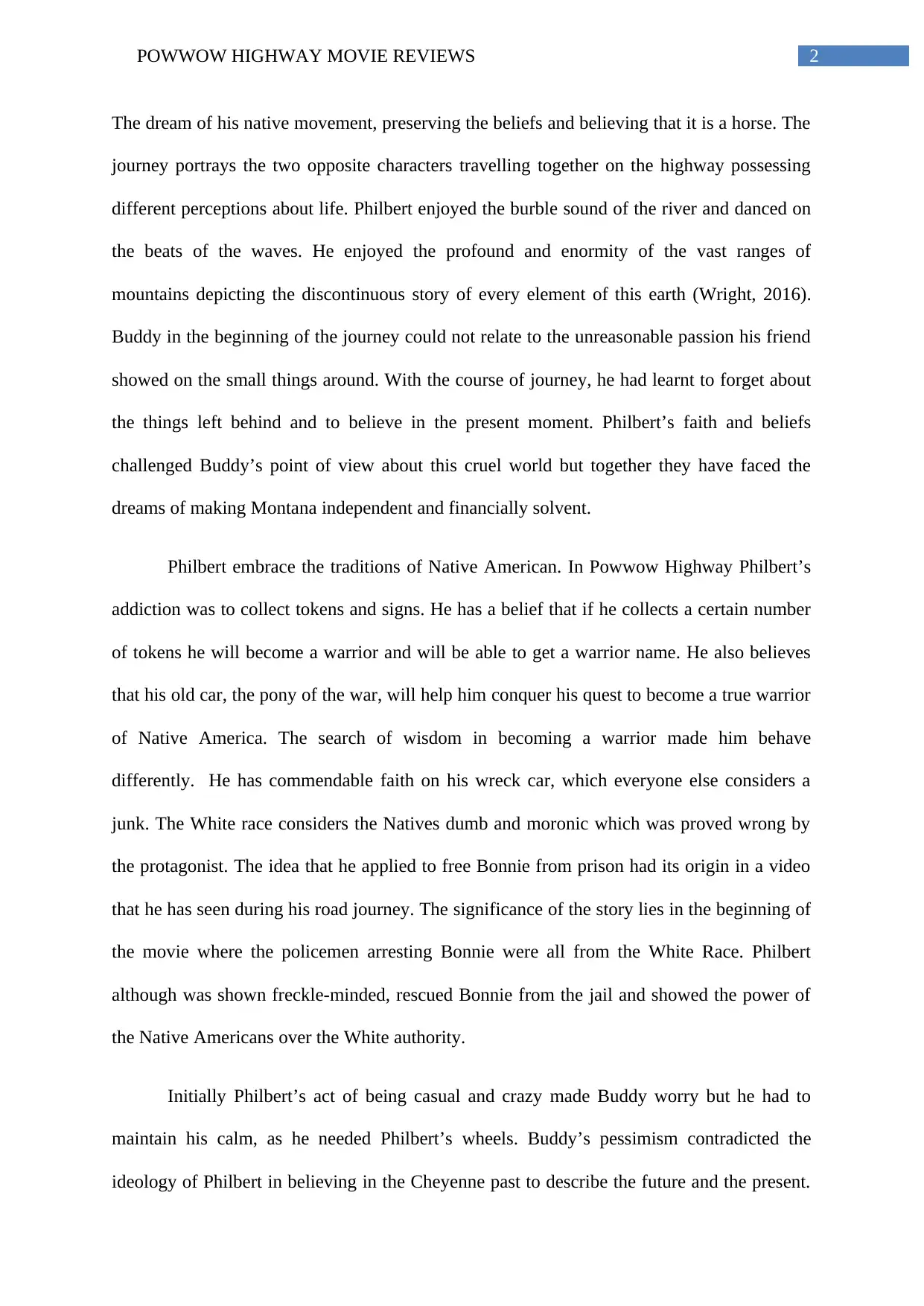
2POWWOW HIGHWAY MOVIE REVIEWS
The dream of his native movement, preserving the beliefs and believing that it is a horse. The
journey portrays the two opposite characters travelling together on the highway possessing
different perceptions about life. Philbert enjoyed the burble sound of the river and danced on
the beats of the waves. He enjoyed the profound and enormity of the vast ranges of
mountains depicting the discontinuous story of every element of this earth (Wright, 2016).
Buddy in the beginning of the journey could not relate to the unreasonable passion his friend
showed on the small things around. With the course of journey, he had learnt to forget about
the things left behind and to believe in the present moment. Philbert’s faith and beliefs
challenged Buddy’s point of view about this cruel world but together they have faced the
dreams of making Montana independent and financially solvent.
Philbert embrace the traditions of Native American. In Powwow Highway Philbert’s
addiction was to collect tokens and signs. He has a belief that if he collects a certain number
of tokens he will become a warrior and will be able to get a warrior name. He also believes
that his old car, the pony of the war, will help him conquer his quest to become a true warrior
of Native America. The search of wisdom in becoming a warrior made him behave
differently. He has commendable faith on his wreck car, which everyone else considers a
junk. The White race considers the Natives dumb and moronic which was proved wrong by
the protagonist. The idea that he applied to free Bonnie from prison had its origin in a video
that he has seen during his road journey. The significance of the story lies in the beginning of
the movie where the policemen arresting Bonnie were all from the White Race. Philbert
although was shown freckle-minded, rescued Bonnie from the jail and showed the power of
the Native Americans over the White authority.
Initially Philbert’s act of being casual and crazy made Buddy worry but he had to
maintain his calm, as he needed Philbert’s wheels. Buddy’s pessimism contradicted the
ideology of Philbert in believing in the Cheyenne past to describe the future and the present.
The dream of his native movement, preserving the beliefs and believing that it is a horse. The
journey portrays the two opposite characters travelling together on the highway possessing
different perceptions about life. Philbert enjoyed the burble sound of the river and danced on
the beats of the waves. He enjoyed the profound and enormity of the vast ranges of
mountains depicting the discontinuous story of every element of this earth (Wright, 2016).
Buddy in the beginning of the journey could not relate to the unreasonable passion his friend
showed on the small things around. With the course of journey, he had learnt to forget about
the things left behind and to believe in the present moment. Philbert’s faith and beliefs
challenged Buddy’s point of view about this cruel world but together they have faced the
dreams of making Montana independent and financially solvent.
Philbert embrace the traditions of Native American. In Powwow Highway Philbert’s
addiction was to collect tokens and signs. He has a belief that if he collects a certain number
of tokens he will become a warrior and will be able to get a warrior name. He also believes
that his old car, the pony of the war, will help him conquer his quest to become a true warrior
of Native America. The search of wisdom in becoming a warrior made him behave
differently. He has commendable faith on his wreck car, which everyone else considers a
junk. The White race considers the Natives dumb and moronic which was proved wrong by
the protagonist. The idea that he applied to free Bonnie from prison had its origin in a video
that he has seen during his road journey. The significance of the story lies in the beginning of
the movie where the policemen arresting Bonnie were all from the White Race. Philbert
although was shown freckle-minded, rescued Bonnie from the jail and showed the power of
the Native Americans over the White authority.
Initially Philbert’s act of being casual and crazy made Buddy worry but he had to
maintain his calm, as he needed Philbert’s wheels. Buddy’s pessimism contradicted the
ideology of Philbert in believing in the Cheyenne past to describe the future and the present.
⊘ This is a preview!⊘
Do you want full access?
Subscribe today to unlock all pages.

Trusted by 1+ million students worldwide
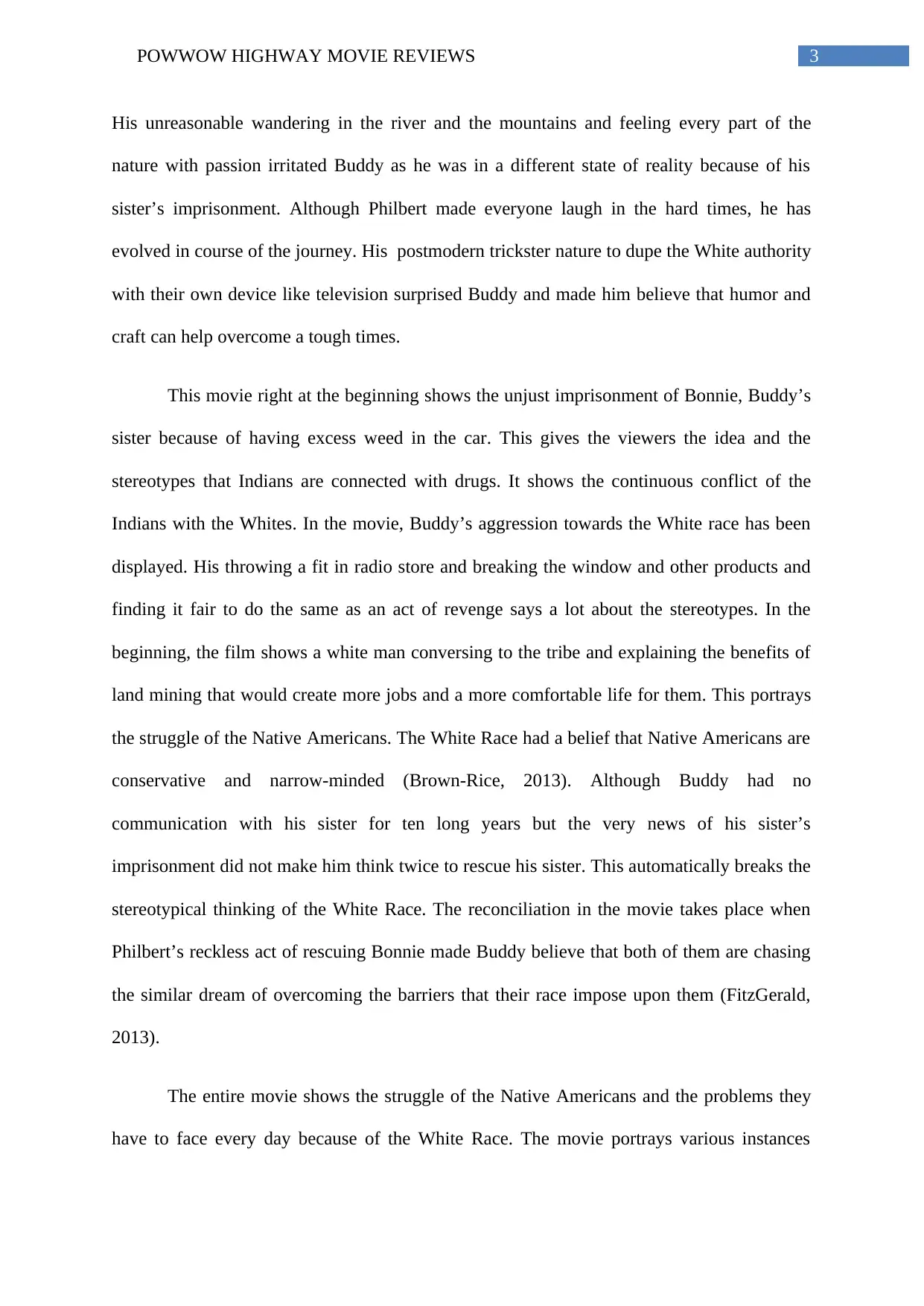
3POWWOW HIGHWAY MOVIE REVIEWS
His unreasonable wandering in the river and the mountains and feeling every part of the
nature with passion irritated Buddy as he was in a different state of reality because of his
sister’s imprisonment. Although Philbert made everyone laugh in the hard times, he has
evolved in course of the journey. His postmodern trickster nature to dupe the White authority
with their own device like television surprised Buddy and made him believe that humor and
craft can help overcome a tough times.
This movie right at the beginning shows the unjust imprisonment of Bonnie, Buddy’s
sister because of having excess weed in the car. This gives the viewers the idea and the
stereotypes that Indians are connected with drugs. It shows the continuous conflict of the
Indians with the Whites. In the movie, Buddy’s aggression towards the White race has been
displayed. His throwing a fit in radio store and breaking the window and other products and
finding it fair to do the same as an act of revenge says a lot about the stereotypes. In the
beginning, the film shows a white man conversing to the tribe and explaining the benefits of
land mining that would create more jobs and a more comfortable life for them. This portrays
the struggle of the Native Americans. The White Race had a belief that Native Americans are
conservative and narrow-minded (Brown-Rice, 2013). Although Buddy had no
communication with his sister for ten long years but the very news of his sister’s
imprisonment did not make him think twice to rescue his sister. This automatically breaks the
stereotypical thinking of the White Race. The reconciliation in the movie takes place when
Philbert’s reckless act of rescuing Bonnie made Buddy believe that both of them are chasing
the similar dream of overcoming the barriers that their race impose upon them (FitzGerald,
2013).
The entire movie shows the struggle of the Native Americans and the problems they
have to face every day because of the White Race. The movie portrays various instances
His unreasonable wandering in the river and the mountains and feeling every part of the
nature with passion irritated Buddy as he was in a different state of reality because of his
sister’s imprisonment. Although Philbert made everyone laugh in the hard times, he has
evolved in course of the journey. His postmodern trickster nature to dupe the White authority
with their own device like television surprised Buddy and made him believe that humor and
craft can help overcome a tough times.
This movie right at the beginning shows the unjust imprisonment of Bonnie, Buddy’s
sister because of having excess weed in the car. This gives the viewers the idea and the
stereotypes that Indians are connected with drugs. It shows the continuous conflict of the
Indians with the Whites. In the movie, Buddy’s aggression towards the White race has been
displayed. His throwing a fit in radio store and breaking the window and other products and
finding it fair to do the same as an act of revenge says a lot about the stereotypes. In the
beginning, the film shows a white man conversing to the tribe and explaining the benefits of
land mining that would create more jobs and a more comfortable life for them. This portrays
the struggle of the Native Americans. The White Race had a belief that Native Americans are
conservative and narrow-minded (Brown-Rice, 2013). Although Buddy had no
communication with his sister for ten long years but the very news of his sister’s
imprisonment did not make him think twice to rescue his sister. This automatically breaks the
stereotypical thinking of the White Race. The reconciliation in the movie takes place when
Philbert’s reckless act of rescuing Bonnie made Buddy believe that both of them are chasing
the similar dream of overcoming the barriers that their race impose upon them (FitzGerald,
2013).
The entire movie shows the struggle of the Native Americans and the problems they
have to face every day because of the White Race. The movie portrays various instances
Paraphrase This Document
Need a fresh take? Get an instant paraphrase of this document with our AI Paraphraser

4POWWOW HIGHWAY MOVIE REVIEWS
showing how the protagonist and his friend have survived through the hardship and win over
the White authority towards the end (Charles, 2017).
showing how the protagonist and his friend have survived through the hardship and win over
the White authority towards the end (Charles, 2017).
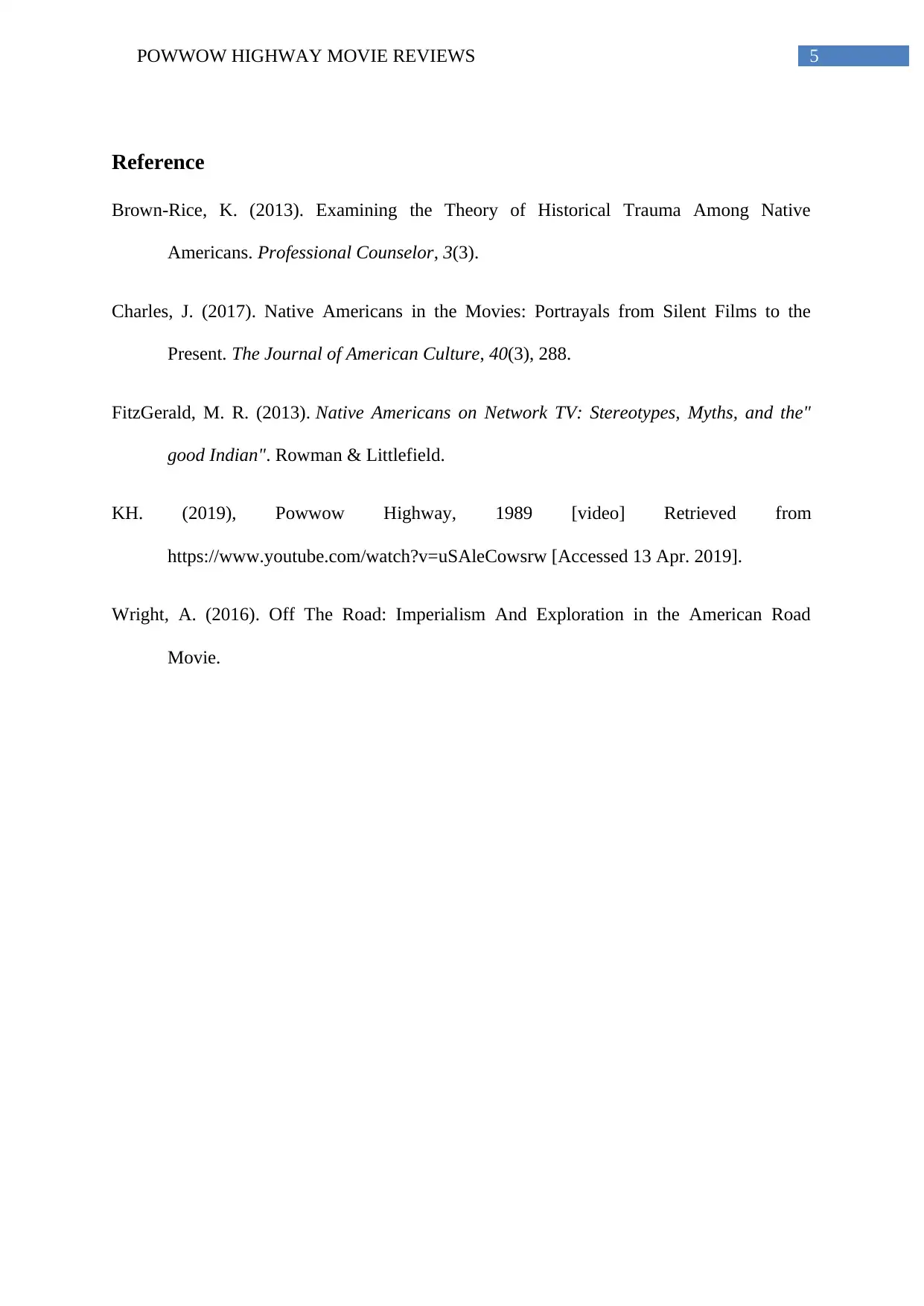
5POWWOW HIGHWAY MOVIE REVIEWS
Reference
Brown-Rice, K. (2013). Examining the Theory of Historical Trauma Among Native
Americans. Professional Counselor, 3(3).
Charles, J. (2017). Native Americans in the Movies: Portrayals from Silent Films to the
Present. The Journal of American Culture, 40(3), 288.
FitzGerald, M. R. (2013). Native Americans on Network TV: Stereotypes, Myths, and the"
good Indian". Rowman & Littlefield.
KH. (2019), Powwow Highway, 1989 [video] Retrieved from
https://www.youtube.com/watch?v=uSAleCowsrw [Accessed 13 Apr. 2019].
Wright, A. (2016). Off The Road: Imperialism And Exploration in the American Road
Movie.
Reference
Brown-Rice, K. (2013). Examining the Theory of Historical Trauma Among Native
Americans. Professional Counselor, 3(3).
Charles, J. (2017). Native Americans in the Movies: Portrayals from Silent Films to the
Present. The Journal of American Culture, 40(3), 288.
FitzGerald, M. R. (2013). Native Americans on Network TV: Stereotypes, Myths, and the"
good Indian". Rowman & Littlefield.
KH. (2019), Powwow Highway, 1989 [video] Retrieved from
https://www.youtube.com/watch?v=uSAleCowsrw [Accessed 13 Apr. 2019].
Wright, A. (2016). Off The Road: Imperialism And Exploration in the American Road
Movie.
⊘ This is a preview!⊘
Do you want full access?
Subscribe today to unlock all pages.

Trusted by 1+ million students worldwide
1 out of 6
Your All-in-One AI-Powered Toolkit for Academic Success.
+13062052269
info@desklib.com
Available 24*7 on WhatsApp / Email
![[object Object]](/_next/static/media/star-bottom.7253800d.svg)
Unlock your academic potential
Copyright © 2020–2025 A2Z Services. All Rights Reserved. Developed and managed by ZUCOL.